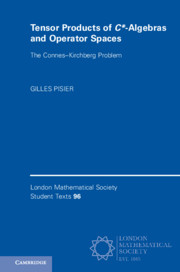Book contents
- Frontmatter
- Contents
- Introduction
- 1 Completely bounded and completely positive maps
- 2 Completely bounded and completely positive maps
- 3 C*-algebras of discrete groups
- 4 C*-tensor products
- 5 Multiplicative domains of c.p. maps
- 6 Decomposable maps
- 7 Tensorizing maps and functorial properties
- 8 Biduals, injective von Neumann algebras, and C*-norms
- 9 Nuclear pairs, WEP, LLP, QWEP
- 10 Exactness and nuclearity
- 11 Traces and ultraproducts
- 12 The Connes embedding problem
- 13 Kirchberg’s conjecture
- 14 Equivalence of the two main questions
- 15 Equivalence with finite representability conjecture
- 16 Equivalence with Tsirelson’s problem
- 17 Property (T) and residually finite groups
- 18 The WEP does not imply the LLP
- 19 Other proofs that C(n)
- 20
Local embeddability into C and nonseparability of (OSn, dcb)- 21
WEP as an extension property- 22
Complex interpolation and maximal tensor product- 23
Haagerup’s characterizations of the WEP- 24
Full crossed products and failure of WEP for B ⊗min B- 25
Open problems- Appendix
Miscellaneous backgroundReferencesIndex - 20
20 - Local embeddability into C and nonseparability of (OSn, dcb)
Published online by Cambridge University Press: 10 February 2020
- Frontmatter
- Contents
- Introduction
- 1 Completely bounded and completely positive maps
- 2 Completely bounded and completely positive maps
- 3 C*-algebras of discrete groups
- 4 C*-tensor products
- 5 Multiplicative domains of c.p. maps
- 6 Decomposable maps
- 7 Tensorizing maps and functorial properties
- 8 Biduals, injective von Neumann algebras, and C*-norms
- 9 Nuclear pairs, WEP, LLP, QWEP
- 10 Exactness and nuclearity
- 11 Traces and ultraproducts
- 12 The Connes embedding problem
- 13 Kirchberg’s conjecture
- 14 Equivalence of the two main questions
- 15 Equivalence with finite representability conjecture
- 16 Equivalence with Tsirelson’s problem
- 17 Property (T) and residually finite groups
- 18 The WEP does not imply the LLP
- 19 Other proofs that C(n)
- 20 Local embeddability into C and nonseparability of (OSn, dcb)
- 21 WEP as an extension property
- 22 Complex interpolation and maximal tensor product
- 23 Haagerup’s characterizations of the WEP
- 24 Full crossed products and failure of WEP for B ⊗min B
- 25 Open problems
- Appendix Miscellaneous background
- References
- Index
Summary
While random matrices give us the exact value of the constant C(n), it is natural to search for alternate deterministic constructions that show that C(n)<n. This chapter explores this direction. The central notion here is that of spectral gap. To prove the key estimate that C(n)<n, it suffices to produce sequences of n-tuples of unitary matrices exhibiting a certain kind of spectral gap. The notion of quantum expanders naturally enter the discussion here. Their existence can be derived from that of groups with property (T) admitting sufficiently many finite dimensional unitary representations. The notion of quantum spherical code that we introduce hereis a natural way to describe what is needed in the present context.
- Type
- Chapter
- Information
- Tensor Products of C*-Algebras and Operator SpacesThe Connes–Kirchberg Problem, pp. 344 - 357Publisher: Cambridge University PressPrint publication year: 2020

